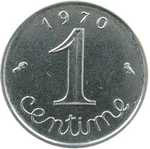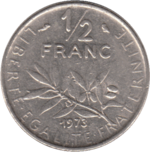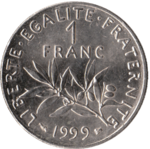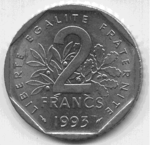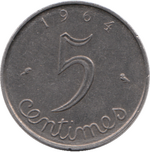French franc
The French franc was the official currency of France, before the entry into circulation of the euro between January 1, 1999 and February 17, 2002. It was divided into 100 cents. Its ISO 4217 code was FRF and its abbreviation is fr.
History
Origins
The franc was originally a French 3.87 g coin minted in 1360 for the release of King John II the Good from being held by the English since his capture at the Battle of Poitiers four years earlier. It was equivalent to one livre tournois (Pound of Tours).
Although Louis XIII abolished the franc as legal tender in 1641 in favor of the gold louis or escudo (écu), the word "franc" continued to be used colloquially to refer to the pound.
Between the French Revolution and the 19th century
During the French Revolution, the franc was reintroduced on April 7, 1795 as the national currency by the government of the National Convention, as a decimal unit of 4.5 g< /span> of fine silver.
With the creation of the gold franc in 1803, units of gold and silver circulated illegally. The ratio of the values of the two metals was 1 to 15.1.
In late 1865, France, Italy, Switzerland, and Belgium created the Latin Monetary Union, which set their respective currencies to a standard of 4.5 g of silver or 0.290322 of gold based on the French franc and with free circulation between these countries. This union worked practically, with the incorporation of Greece in 1868 and the parallel adoption of the same standard in some other nearby countries, until the beginning of the 20th century.
World War I and devaluations
World War I broke the stability of the Latin Monetary Union, by calling into question the strength of the French franc, due to the expenses caused by the war itself, inflation and the reconstruction of the country financed in part through the printing of a larger amount of money. All this reduced the purchasing power of the franc by 70% between 1915 and 1920 and 43% between 1922 and 1926. After a brief return to the gold standard between 1928 and 1936, the currency continued to lose value, until it was worth less in 1959. of a fortieth of what it was worth in 1936.
The new frank
In January 1960, due to the low value of the franc, the "new French franc" with a value of 100 old francs = 1 new franc. All the old denominations of francs followed, especially coins; circulating as cents, and the abbreviation NF (nouveau franc) was used for a while. Inflation continued to erode the value of the French currency, but at a very slow rate compared to the currencies of other countries, so that in 2002, the year it was replaced by the euro, the new franc was worth less than one eighth of its original value.
Many Frenchmen of a certain age continued to calculate in old francs, anciens francs, and even large sums of money such as lottery prizes continued to be awarded in pence, as these were equivalent to the old franc. This usage lasted until the abolition of the franc in 2002, and there was speculation that the elders would continue to carry the conversion factor between old francs and new francs to the euro, calling the reduced version of it, naturally, euro ancien.
Since January 1, 1999, the value of the French franc was fixed at exactly 6.55957 francs per euro, the currency that replaced it between January 1 and February 17, 2002.
The French often mentally calculate prices in euros using 20 francs for every 3 euros (6.6 francs per euro) as a conversion factor. To do this, they add half to the price in francs and divide the result by 10. The error in this mental conversion is 1.6%.
Coins
The last coins in circulation, before the entry of the euro, were those of the following denominations:
Since 1960, 5 cent coins were made of stainless steel and it was not until 1966 when they began to be minted with different materials and designs.
Initially, when the French franc was revalued, ½ coins did not exist until 1965, instead 50 cent coins circulated.
| Image | Denomination | Metal | Diameter (mm) | Weight (g) | Song | Reverse | Reversal | |
|---|---|---|---|---|---|---|---|---|
| Ring | Centre | |||||||
| 50 cents | Aluminium Bronze | 25,00 | 7.00 | Liso | Marianne - REPUBLIQUE FRANÇAISE | 50 CENTIMES - Olive branch - Wheat spike - LIBERTE·EGALITE·FRATERNITE - year of watering | ||
A similar case occurred with the 10-franc coins, which were put into circulation in 1974. They were minted in a single material and only in 1988 did they begin to be replaced by bimetallic ones.
Tickets
The banknotes in circulation, before the entry of the euro, were those of the following denominations:
| Predecessor: Old | New 1960-1999 (of Jure) 2002 (invoice) | Successor: Euro |
Contenido relacionado
Marketing strategy
Royalty
Sales indicator
